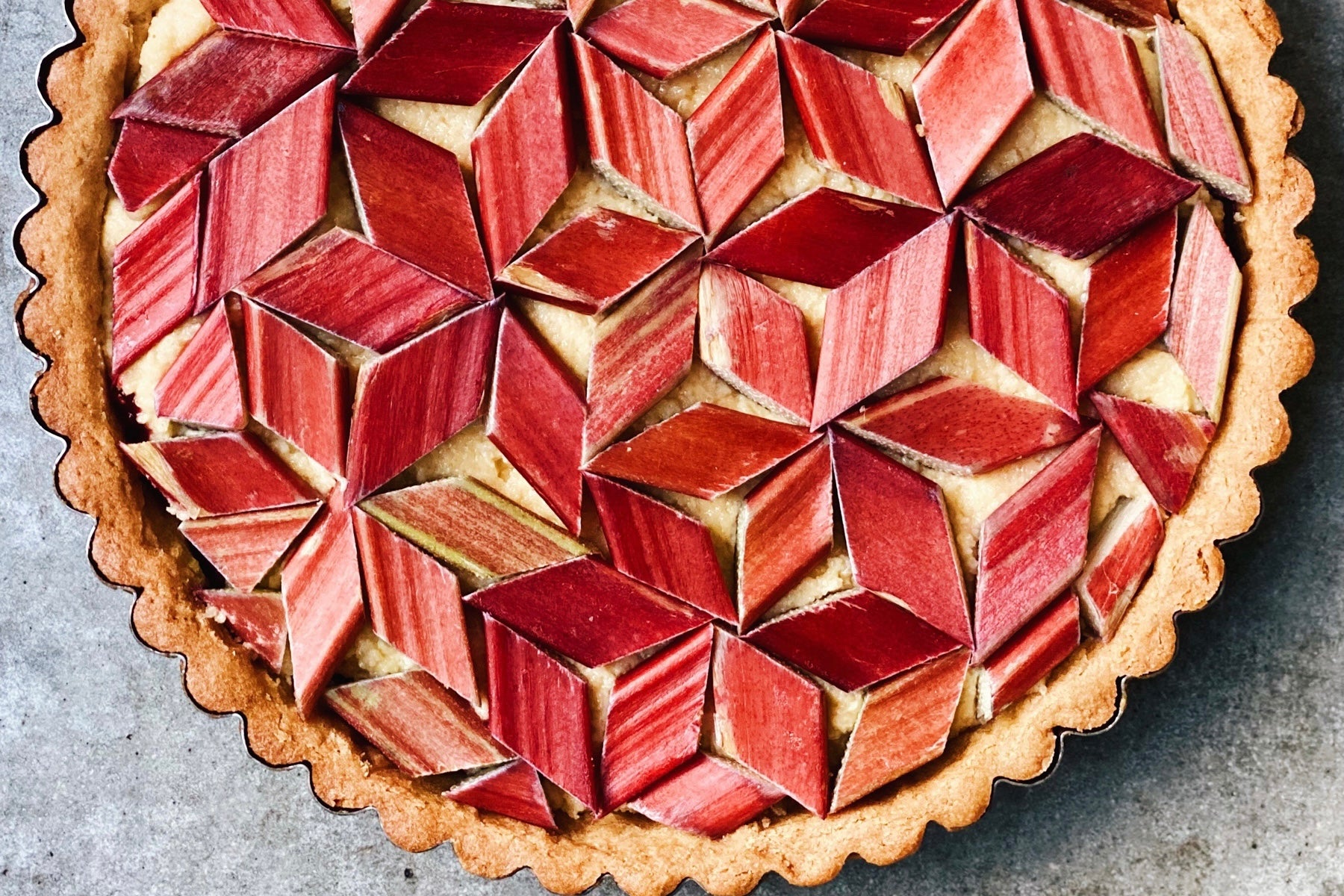This tessellated rhubarb tart was inspired by Thida Bevington, who creates spectacular pastries with geometric patterns. We used a 8" fluted tart pan with removable base but a pie plate will work just as well. For a more straightforward pattern, you can simply lay rhubarb stalks across the tart or cut rhubarb into coins and overlap them slightly in a spiral. Regardless of the pattern you choose, we found it helpful to find rhubarb stalks with similar widths.
Rhubarb Frangipane Tart
1 lb rhubarb, thinner and uniform stalks if possible
3 tbsp raspberry jam
Pâte Sablée (Sweet Tart Dough)
Recipe by Dorie Greenspan
1 1/2 cup (225 g) Flourist Sifted Red Fife Wheat Flour
1/2 cup (60 g) confectioner's sugar
1/4 tsp salt
9 tbsp (128 g) butter, cold and cut into small cubes
2 large egg yolks
Almond Frangipane
1 cup (100 g) ground almond meal
1/2 cup (115 g) butter, room temperature
1/2 cup (100 g) sugar
2 large eggs
3 tbsp Flourist Sifted Red Fife Wheat Flour
pinch of salt
Pâte Sablée
To make the pâte sablée, place flour, confectioner's sugar and salt in a food processor. Pulse a few times to combine. Sprinkle the butter pieces all over and pulse to incorporate. The butter pieces should be roughly the size of a pea. In a small bowl, stir the yolks with a fork to break it up and tip it into the food processor a little at a time, pulsing after each addition. Once yolks are incorporated, process in 10 second long pulses until the dough starts to clump together. Turn dough out onto a clean, working surface.
The dough is finished with a French technique called Fraisage which ensures that the butter is properly distributed and that all the dry ingredients have been worked in. Take a few tablespoons of dough at a time and with the heel of your hand, smear the dough outwards a few inches across your work surface. Gather all the smeared pieces and shape the dough into a disc. Roll dough out between two sheets of parchment or wax paper until it's about 3-inches larger in diameter than the base of your tart pan. You may need to lift the paper up occasionally to prevent the paper from rolling into the dough and creating creases. Once fully rolled out, slide the paper onto a baking sheet and refrigerate the dough for at least an hour.
Thoroughly butter the tart pan, making sure to get into all the creases and rounded edges. When the dough is thoroughly chilled, remove from fridge and place on the counter to rest for about 10 minutes, until the dough is just pliable to work with, without breaking. Peel off paper and gently ease the dough into the prepared tart pan, pressing the dough firmly into the corners of the pan. Trim the excess dough off the top. Dock with a fork and tightly wrap with plastic wrap, place in freezer until frozen.
When you're ready to bake, preheat oven to 400°F and place a baking sheet in the oven to heat up. Butter the shiny side of a piece of aluminium foil that will fit over the crust completely. Press the foil tightly into the bottom and edges of the crust. Pour pie weights (dry beans, rice or sugar also work well) onto the aluminum foil and fill until close to the top. Place pie pan on the pre-heated baking sheet (don't forget the pan will be very hot!) and bake for approximately 25, until the dough is set and almost dry to the touch. Transfer to a cooling rack.
Almond Frangipane
In the bowl of a standing mixer or with handheld beaters, cream butter and sugar together until light and fluffy. Add ground almonds and continue beating until incorporated. Scrape the bottom of the bowl with a rubber spatula. Add eggs one at a time, mixing thoroughly after each addition. Tip in flour and salt and mix until just combined. Transfer frangipane into a piping bag or a disposable zip-top bag.
Assembly
With an offset spatula, evenly spread raspberry jam across the bottom of the tart crust. If using a disposable zip-top bag, snip a small corner off and pipe the frangipane on top of the jam. Piping will be easier than spreading it with a spoon or spatula because the frangipane will slide on the jam.
Wash rhubarb and cut into desired shapes. For a tessellated pattern, cut rhubarb into diamond shapes with each side as equal as possible. It was helpful to practice the design on a clean cutting board first before arranging in the tart. Arrange 6 diamonds in a flower shape, starting in the centre. Continue making inter-locked flower shapes as you work outwards. At the edges you may need to custom cut the rhubarb to fit precisely.
Preheat oven to 350°F and bake for 25-35 minutes, until the frangipane is set and has puffed. Place on a cooling rack. Serve warm or at room temperature.



Comments
Hi Nick! We didn’t find that the rhubarb was tough or bitter from being roasted as is, it softens in the oven and is balanced in flavour by the frangipane. Tossing the rhubarb in lemon juice and sugar would be fine or just sprinkling sugar on top of the whole tart before baking. Happy baking!
Planning to bake this but I’m concerned the rhubarb will be too tough and bitter just being baked sitting on top of the tart for 25-30 mins. Perhaps coating with some sugar and lemon juice before arranging on top and baking might help? Curious if anyone has made this and how it turned out!